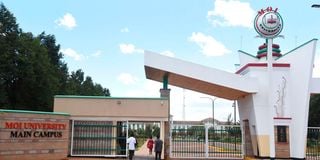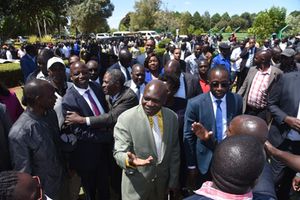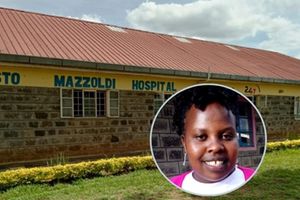
The entrance to Moi University's main campus in Kesses, Uasin Gishu County on February 8, 2024.
Unlike many other institutions of higher learning, Moi University was founded under three tents and on the lawn of a hotel.
The entire student population and faculty were taken by bus 310 kilometres away to start the new university, which has been in the news recently for all the wrong reasons.
That was on October 1, 1984, when 83 students from the University of Nairobi's Department of Forestry arrived at the Kaptagat Hotel because the proposed new campus in Kesses, Uasin Gishu County, had no buildings.
The students stayed at the hotel.
Former Education Permanent Secretary James Ole Kiyiapi was among the pioneers.
Moi University should be celebrating its 40th birthday, but instead it finds itself in the eye of a storm, mired in mismanagement and allegations of corruption, weighed down by heavy debts, a disillusioned staff and a student population whose studies are frequently disrupted by strikes.
The university was established on the recommendation of the Presidential Working Party on a second university in Kenya, set up by President Daniel arap Moi in 1981. The team was chaired by Dr Colin B Mackay (a Canadian educationist) and deputised by Prof Douglas Odhiambo.
President Moi formed the task force because the University of Nairobi could not accommodate the growing student population.
However, it was the President who chose the location and name of the university. His intention was to decentralise higher education away from Nairobi, where most other tertiary institutions were located.
“As the site for the university was not one of the terms of reference of the working party, no recommendation has been made in this regard. However, selection of the site is an important early step in the implementation of the recommendations. In deciding on this matter, consideration should also be given to the possibility of the university starting in temporary quarters, while the building programmes are in progress,” the report reads.
Although changing the education system was not in the remit of the working group, one of its by-products was a proposal to scrap the A-level system in favour of the 8-4-4 system, which was eventually introduced in 1985. It would remain in place until its gradual replacement by the Competency Based Curriculum (CBC), which began in 2019.
When Moi University was finally established by an Act of Parliament (Moi University Act, 1984), President Moi appointed Prof Odhiambo as its first Vice-Chancellor.
The President was its Chancellor, and for UoN as well. President Moi assumed the role of Chancellor in all other universities that were established later, and the trend was only reversed by his successor, Mwai Kibaki, who appointed other people to the positions.
Prof Odhiambo accompanied the students by road from Nairobi to a literal tent at the Kaptagat Hotel. One tent served as his administrative block, while the other two served as lecture halls. The nearby Kaptagat Forest also served as a valuable resource for the forestry students.
Prof Odhiambo, a scientist of no mean repute, is also credited with the establishment of the International Centre for Insect Physiology and Ecology (Icipe). He also chaired the Task Force on the Realignment of the Education Sector to the Constitution of Kenya, 2010.
It was this task force that recommended a change in the structure of the education system from 8-4-4 to the current 2-6-3-3-3.
The Mackay team also recommended the faculties to be established at the new university, along with the proposed number of students. The academic programmes were science-based because that was the vision of the university to meet national development needs.
These were the Faculty of Technology (1,120), the Faculty of Agriculture (800), the Faculty of Natural Sciences (512), the Faculty of Veterinary Medicine (320), the Faculty of Forest Resources and Wildlife Management (192), the Faculty of Social, Cultural and Development Studies (160) and the Faculty of Information Sciences (96).
Also recommended were the Faculties of Graduate Studies, Environmental Studies and the Institute of Applied Science and Technology. No figures were given for these. The number of staff required at that time was 242.
The proposed total number of students was 3,200. Since then, the number has grown to around 40,000 and the academic offer has expanded, but so have the problems plaguing the institution.
On Friday, the National Assembly's Education Committee called for the dissolution of the university's board of directors, blaming it for the current problems. Staff unions have also demanded the removal of Vice Chancellor Isaac Kosgey as one of the conditions for them to resume work.
Academic and non-academic staff at the university have been on strike and have refused to resume work, demanding the payment of Sh10 billion owed to them in salary arrears and unremitted third party deductions.
The recent management problems at Moi University can be traced to political interference, which began in 2016 when politicians mobilised and stormed the institution to demand the recruitment of a VC from the region. They were protesting against the appointment of Prof Laban Ayiro (whom they considered an 'outsider') and demanded that Prof Kosgey take over.
Among the politicians were two sitting governors, Jackson Mandago (Uasin Gishu) and Alex Tolgos (Elgeyo Marakwet). Others were MPs Oscar Sudi (Kapseret) and Silas Tiren (Moiben). The leaders were censured by the National Cohesion and Integration Commission, which accused them of tribalism.
At the end of the saga, Prof Kosgey was appointed VC, while after being rejected, Prof Ayiro went to Daystar University where he was appointed VC in 2019 and is still in the position.
In his book, The Art of Institutional Leadership: Unleashing the Potential of Emotional Intelligence, Prof Ayiro has dedicated a chapter titled "Overcoming Political Shenanigans" to what happened at Moi University.
“A (university) council member who would pass for a stranger in the council, both by qualification and age, awarded me the lowest mark I have ever scored in my entire learning journey from primary to university: 44 percent! The same council member awarded my competitor 97 percent!” writes Prof Ayiro in his book.
It was not all doom and gloom, however, as the university has mentored other constituent colleges that have gone on to become chartered universities in their own right. These include Maseno University, Masinde Muliro University of Science and Technology, Maasai Mara University, Kabianga University, Eldoret University, Karatina University, Rongo University, Garissa University and Alupe University. Bomet University College is still under its auspices as a constituent college.









